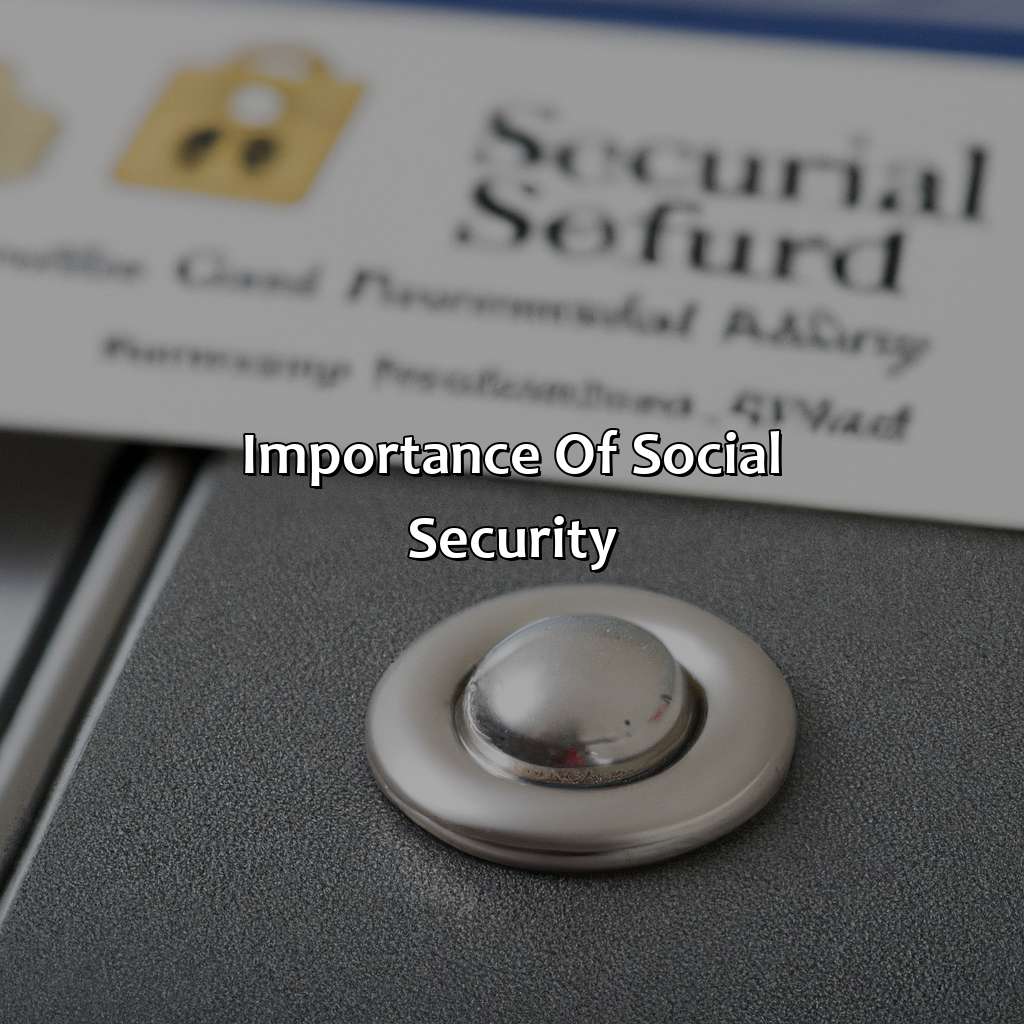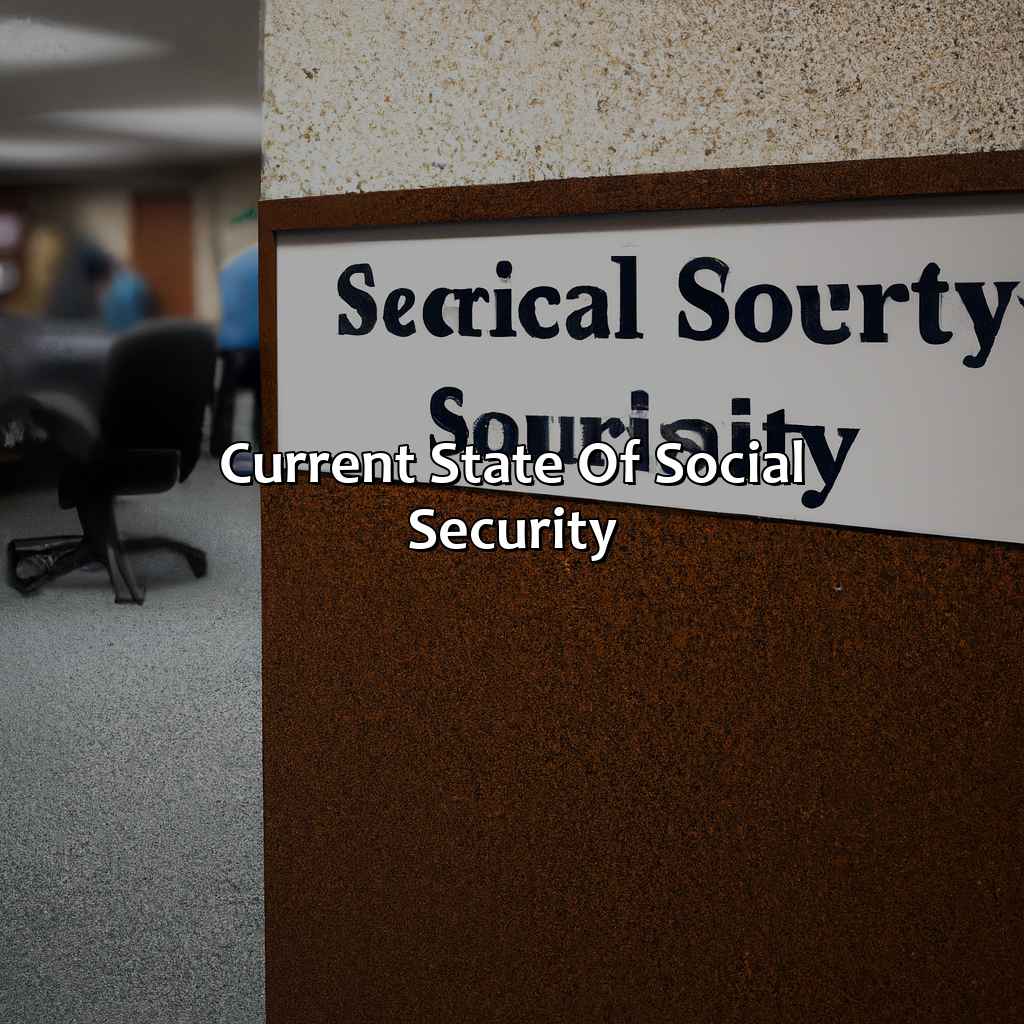How Safe Is Social Security?
Key Takeaway:
- Social Security is an important program that provides financial support for retired and disabled individuals as well as their families, but it is facing challenges due to current demographic trends and budget constraints.
- Trust Fund Reserves for Social Security are projected to be depleted in the next few decades, and political challenges may further impede timely solutions to this issue.
- To ensure the safety and sustainability of Social Security, potential solutions include increasing revenue, cutting benefits, and expanding eligibility, but these options must be considered carefully to balance the needs of beneficiaries and the financial stability of the program.
You deserve to feel secure and confident in your future. But with the ever-changing economy and society, how can you be sure of your Social Security benefits? This article looks at the safety and security of Social Security funds in today’s world.
Importance of Social Security
Social Security is an integral part of people’s lives, providing an essential safety net for those who are unable to work due to old age, disability or other reasons. Without Social Security, many individuals would be left without any means of support, potentially leading to poverty and hardship. This makes it crucial for policy makers to ensure the long-term sustainability of the program.
Considering the current political and economic climate, how safe is Social Security? Many experts opine that the program is facing significant challenges due to factors such as the aging population, lower birth rates and slower economic growth. However, there are steps that can be taken to ensure the program’s stability, such as increasing the retirement age, reducing benefits for higher-income earners and increasing contributions.
It is important to note that despite these challenges, Social Security remains a vital source of income for millions of Americans. In fact, without Social Security benefits, roughly half of all seniors would be living in poverty. The program serves as a critical source of support for many vulnerable populations, including women, minorities and those with disabilities.
To ensure Social Security’s continued success, policymakers must act responsibly and take steps to safeguard the program’s future. By investing in long-term solutions and making necessary adjustments to the program, we can ensure that Social Security remains a vital source of support for generations to come.
In light of these considerations, it is clear that the importance of Social Security cannot be overstated. Policymakers must work proactively to ensure that the program remains sustainable and effective, providing a critical source of support for those who need it most. By taking action now, we can help to secure the future of Social Security for years to come.

Image credits: retiregenz.com by James Jones
Current State of Social Security
Want to get the scoop on Social Security? Dive into the trust fund reserves and political struggles. Grasp the significance of these two sub-sections to figure out if Social Security is secure for years to come.

Image credits: retiregenz.com by James Duncun
Trust Fund Reserves
Social Security’s financial back-up known as the Trust Fund Reserves holds the key to its future solvency. The reserves comprise two funds, the Old-Age and Survivors Insurance( OASI), and Disability Insurance (DI), set aside for retirement and disability benefits of eligible individuals.
With 2020 surveys revealing that DI reserves would run dry by 2032, one could say that Social Security hangs on a fragile tether. Moreover, trust fund reserves have been consistently declining since 2008 due to demographic shifts such as aging population and decreased birth rates.
It is noteworthy that important policy decisions need to be made soon before it leads to dire consequences such as reduced benefits or increased taxes. As per Investopedia, “The trust fund value peaked in 2008 – just before the Great Recession – at $2.7 trillion”
“Politicians and diapers have one thing in common – they both need to be changed regularly, and for the same reason.”
Political Challenges
Recent turbulence in the political sphere has had a significant impact on the security of social welfare programs. These unpredictable events have destabilized the current state of social security, leaving many beneficiaries concerned about its future. In times like these, a deeper understanding of how these challenges are affecting the program can help beneficiaries make informed decisions about their financial future.
The recent US election has brought renewed attention to funding gaps and potential changes to social security benefits. The incoming administration’s policies on taxes and government spending could have serious implications for the program’s long-term viability. Additionally, shifting demographics and an aging population have created further challenges that will require thoughtful solutions to address.
Despite current uncertainty surrounding social security, there are steps individuals can take to secure their financial stability in retirement. Planning ahead with a diversified investment portfolio or seeking advice from a qualified financial advisor can alleviate some concerns about relying solely on social security income during retirement.
As we navigate these challenging times, it is crucial for individuals to stay informed and engaged with legislative updates that could impact the future of social security. Whether through community advocacy groups or direct engagement with elected representatives, act now and take control of your financial future before it’s too late.
Social Security is like a game of Jenga, except the blocks are retirement funds and the players are the government and economy.
Potential Risks to Social Security
Understand the safety of your social security – be aware of the risks. To reduce these risks, we look at demographic changes, economic downturns and budget restrictions. Quickly check for solutions.

Image credits: retiregenz.com by Adam Arnold
Demographic Changes
The evolving population dynamics are affecting social security. With an ageing population and a declining birth rate, the workforce-to-retirees ratio has decreased. This phenomenon is putting a strain on finances, and new policies must be formulated to ensure sustainability.
This change in demographics has ramifications for both individuals and society as a whole. As fewer workers contribute to social security programs, they will become more expensive, reducing the benefits available to retirees. Moreover, as life expectancy continues to climb, the government faces another challenge of supporting older people over an increasingly long retirement period.
It’s worth noting that demographic changes may not impact everyone equally. Minorities and lower-income workers may bear the brunt of these developments due to various socioeconomic factors like longer life spans than average or lack of access to affordable healthcare. These disparities could worsen if policymakers don’t respond proactively.
A few years ago, an elderly woman who had contributed generously towards social security lost everything after falling victim to a scammer who duped her into giving her finances away. Her savings were meagre and entirely depended on social security benefits that she was receiving regularly before being scammed out of it. Her story is just one example of how vulnerable individuals might be when reliant on social security programs whose future remains uncertain.
“It’s not a real economic downturn until your Social Security number starts feeling like a lucky charm.”
Economic Downturns
The stability of the economy has a direct relationship with the safety of Social Security. When there is an economic downturn, there is lesser money being invested in the system and thus lesser funds available for social security obligations.
This means that if Social Security does not have enough money to fund all its obligations during such times, it may result in reduced benefits or delayed payouts. A prolonged recession can have a significant impact on social security’s long-term finances as it reduces the amount of revenue coming into the system.
It is crucial to note that this reduction in benefits will affect those who rely solely on social security income to support themselves or their family members. A prolonged period of economic downturns can also reduce the government’s credibility, leading to a lack of trust in institutions and increased inequality among citizens.
Therefore, it is essential to consider economic factors when evaluating how safe Social Security programs are for individuals’ long-term financial stability.
In light of these potential risks, individuals should be adequately prepared with alternate sources of income to mitigate any financial impact brought about by reduced benefits or delayed payout from Social Security. It is best to explore different retirement plans, such as investment accounts or pension schemes, and be proactive about saving for retirement rather than being reliant solely on Social Security income.
Looks like the only way to balance the budget is to ask social security to start their own version of a lemonade stand.
Budget Constraints
The financial restrictions on social security expenditure have the potential to trigger instability in its functioning. The budgetary restrictions could lead to a decline in benefits or tax hikes, thereby affecting various social classes relying on the system.
To overcome these constraints, policymakers need to implement effective strategies, including efficient allocation of funds and prudent investment decisions. Revising the social security retirement age limit, aligning retiree benefits with life expectancy rates, and optimizing disability grants’ eligibility criteria are some of the measures to address budget pressures.
Disruptive economic events impact social security programs drastically. The Great Recession of 2008 caused a significant dip in funding for Social Security’s Trust Fund that has since recovered from its effects through increased taxes.
Social security faces many threats that threaten its sustainability and ability to provide comprehensive social support for individuals and families. Budget constraints pose one such threat that governments must tackle with utmost caution and wisdom.
Don’t worry, Social Security will be secure as long as we keep electing politicians who don’t believe in science or math.
Solutions to Secure Social Security
To protect Social Security, there are solutions. For example, increasing revenue, cutting benefits, and expanding eligibility.
Let’s look at each one closely to see if it works. What can we do to make sure Social Security is safe? Let’s investigate the answers!

Image credits: retiregenz.com by James Duncun
Increase Revenue
Boosting Social Security Funds with Innovative Strategies
With the ever-evolving financial landscape, it’s critical to find smart ways to augment income for the Social Security fund. Explore methods that could enhance revenue streams, including diversifying the investment portfolio and increasing payroll taxes.
One method to raise funds is by increasing taxes on affluent earners. The plan proposes a lift of 2% hike in the payroll tax from both employers and employees as employed individuals earning over $400,000 each year.
Furthermore, another strategy could be boosting proactive investments in firms. As a result, increasing returns on stocks will increase overall gains, benefiting Social Security funding.
It’s essential to adopt creative strategies for enhancing the security future for America’s retirees. Supporters emphasize improving younger generations’ chances to create a lifelong budget focusing on investment portfolios and savings accounts early on.
There has never been a better time than now to take action towards securing social security solutions for ourselves and our loved ones. Let’s work together towards creating more excellent funding outcomes that can help shape a brighter future.
“Looks like social security isn’t the only thing getting cut these days, say goodbye to your benefits too.”
Cut Benefits
Reducing Social Security Payments
Cutting down benefits in social security may be a possible solution to ensure better safety and security of funds. Here are some key points that can help reduce the payouts:
- Increase the retirement age gradually, so people will earn more before applying for benefits
- Reduce payments to higher-income earners who do not rely on Social Security for their financial well-being
- Alter the cost-of-living adjustment formula slightly to make it more in line with actual inflation rates
- Making beneficiaries pay more for Medicare coverage or cutting back on benefits offered under the program
It is also important to note that these cuts should be implemented judiciously, targeting those who can afford the reduction in payouts, while ensuring that low-income earners continue to receive adequate financial support.
One suggestion is to invest Social Security funds in safe and profitable investments such as low-cost index funds or bonds. This approach will enable Social Security to stay sustainable over long periods of time. Another approach could be implementing policies that boost participation in retirement savings programs, such as increased employer contributions or automatic enrollment.
Let’s expand eligibility to include all those who’ve been ghosted by their exes, at least they’ll have some form of security.
Expand Eligibility
Promoting Access to Social Security Benefits
Extending the reach of Social Security beyond its current limits is a practical solution worth exploring. By improving eligibility criteria and granting benefits to more individuals, the social safety net can expand in scale and efficacy. Here are four ways in which expanding eligibility can supplement Social Security’s capacity:
- Consider inclusion of gig economy workers and self-employed individuals
- Lower minimum age thresholds for receiving benefits
- Adjust income limitations to be responsive to cost of living increases
- Increase outreach efforts for underserved or marginalized communities
Expanding eligibility further facilitates the transition from dependence on employment-based retirement plans to more inclusive models that embrace all categories of labor income. This approach would address concerns regarding wealth inequality, offer a basic standard of living, and create greater access to assistance programs.
Did you know – According to the Social Security Administration’s (SSA) projections, their reserves could be depleted in less than 20 years if measures are not taken to secure their finances?
Five Facts About How Safe Is Social Security:
- ✅ Social security is projected to exhaust its reserves by 2035, leaving only enough funds to pay out 80% of promised benefits. (Source: AARP)
- ✅ Approximately 64 million people received social security benefits in 2020, with an average monthly benefit of $1,543. (Source: SSA)
- ✅ Social security fraud and scams are common, with scammers using phone, email, and social media to impersonate government officials and steal personal information. (Source: FTC)
- ✅ Social security benefits are taxable, with a portion of the benefits subject to federal income tax if a recipient’s income exceeds a certain threshold. (Source: SSA)
- ✅ Social security eligibility requirements include having earned a certain number of credits through work and being at least 62 years old (or disabled). (Source: SSA)
FAQs about How Safe Is Social Security?
How safe is social security?
Social security is generally considered safe as it is a government-run program that provides income support to retirees, disabled individuals, and survivors. However, there are some concerns about the program’s long-term sustainability as the number of beneficiaries increases and the number of workers supporting the program decreases.
What measures are in place to protect social security?
There are several measures in place to protect social security, including regular audits and oversight by the Social Security Administration and Congress. Additionally, the program is funded through payroll taxes, which provides a steady stream of revenue, and there is currently a trust fund in place to ensure that benefits can be paid out even if there is a temporary shortfall in revenue.
Could social security be eliminated?
It is unlikely that social security will be eliminated entirely as it is widely considered a cornerstone of the U.S. retirement system. However, changes to the program, such as raising the retirement age or adjusting benefit formulas, may be necessary in the future to ensure its long-term sustainability.
What happens if there is a social security shortfall?
If there is a temporary shortfall in revenue, the Social Security Administration can draw on the trust fund to ensure that benefits can still be paid out. However, if the shortfall is more severe and long-term, changes to the program may be necessary to ensure its sustainability.
What can individuals do to protect their social security benefits?
Individuals can help protect their social security benefits by maximizing their lifetime earnings, which will increase the amount of their benefits. They can also delay claiming benefits until full retirement age or later to increase their monthly benefit amount. Additionally, individuals should keep their personal information secure to prevent identity theft, which can lead to someone else claiming their benefits.
Is social security only for retirees?
No, social security provides support to retirees, disabled individuals, and survivors. Retirees receive the largest percentage of benefits, but disabled individuals and survivors may also be eligible for benefits depending on their circumstances.


